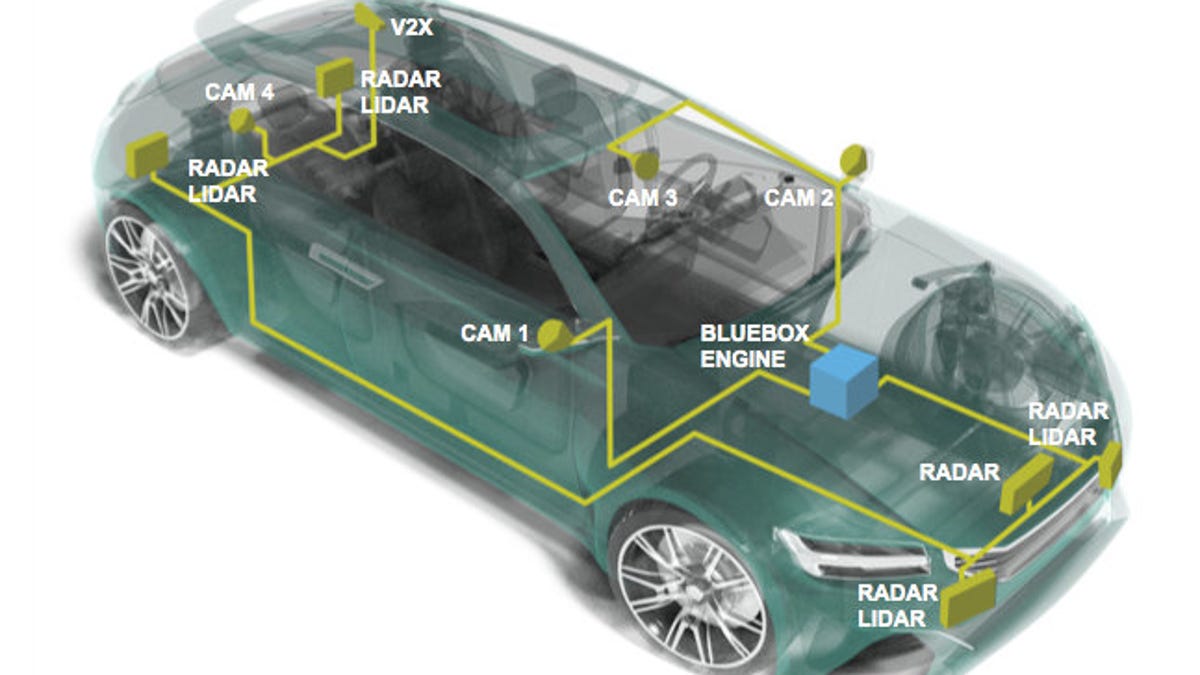Major automakers test self-driving cars with NXP BlueBox computer
NXP announced its BlueBox computer, a mobile computing platform for building and testing self-driving cars that's already in the hands of four major automakers.
While automakers carefully test the technical, public and regulatory waters for future self-driving cars, technology suppliers are already engaged in heated competition. At this year's CES, Nvidia announced a new generation of its Drive PX self-driving car computer, and today, chipmaker NXP announces BlueBox, a computing platform that lets automakers test and develop self-driving cars.
NXP says its new BlueBox computer, currently being tested by four major automakers, will make self-driving cars available to consumers by 2020.
BlueBox uses two chips, the company's S32V vision processor and its LS2088A processor, the latter comprising eight 64-bit ARM Cortex-A72 cores. NXP claims BlueBox processes 90,000 million instructions per second with power consumption at less than 40 watts, a key metric for automotive use. By contrast, Nvidia says its Drive PX 2 computer hits 8 teraflops, a different processing metric, and consumes about 250 watts.
Bob Conrad, senior vice president and general manager of automotive microcontrollers at NXP, said that BlueBox is a development platform that lets automakers test advanced self-driving features. He sees the next generation of hardware beyond BlueBox, optimized for production, as what will really enable self-driving cars in the near future.
Processor unification
Where microcontrollers have spread throughout cars over the last few decades, controlling everything from power mirrors to throttles, self-driving cars need a single powerful computer to process sensor data, decide appropriate actions and then control vehicle speed and direction, all in real time.
Production cars currently offer driver assistance systems that automatically hit the brakes to prevent a collision, maintain following distance behind highway traffic and even control the steering to prevent lane drift, features that will eventually roll up in a completely self-driving car system. NXP notes that it already supplies chips that control driver assistance systems to 8 of the world's top 10 automakers.
Advanced computers like BlueBox take car control to a new level, using data from radar, sonar, cameras and LIDAR to build a virtual world that replicates the outside environment in real time. In that virtual world, the computer makes driving decisions based on programming, taking into account local laws, traffic, pedestrians, bicyclists and even random objects in the road, all the things human drivers encounter on a daily basis.
NXP's Conrad pointed out that he was surprised how quickly automakers were able to implement self-driving features with BlueBox. A car company that was given the platform in September of last year was running a test vehicle by Christmas, accomplishing this feat with just a few months of development time..
Degrees of autonomy
BlueBox enables Level 4 autonomous cars, a standard developed by the Society of Automotive Engineers (SAE) that refers to a vehicle with a high level of automation and a human driver that may be required to take manual control under some situations. NXP says that BlueBox will let automakers put Level 4 autonomous cars on the market by 2020. Level 5 cars, the top of the SAE scale, feature full automation, where a human is not expected to take control.
Self-driving cars have the potential to reduce or eliminate fatalities from crashes. US Traffic fatalities, mostly caused by human error, hit 38,300 in 2015, according to the National Safety Council.


